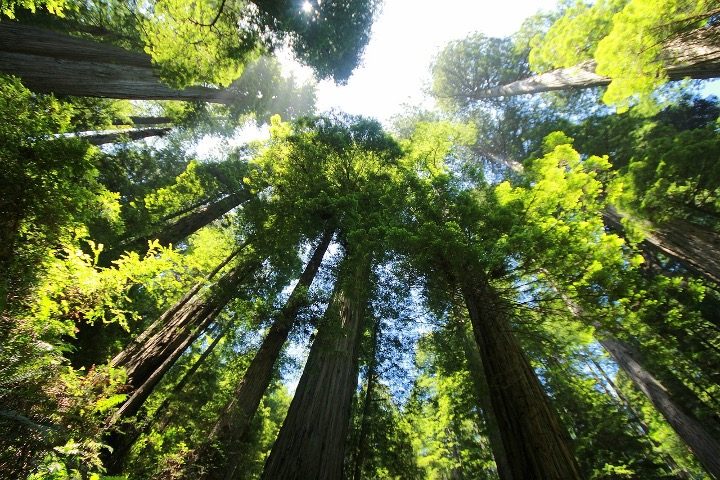
Back in the 1970s, when trees became almost a protected class, we heard that we had to ditch paper supermarket bags (and move to plastic) because we were decimating too many forests. Now, 50 years later, with more tree cover in the U.S. than a century ago, the greentopians have another complaint:
American forests will become CO2 emitters by 2070, they aver, joining 10 protected forests worldwide that already are net spewers of the gas.
Reflecting the complaints many misanthropic leftists have about people, the issue is that as trees age they become takers: Their growth slows and they use less CO2. In fact, the amount metabolized is lower than that produced by wildfires and dead-tree decomposition.
True to form, some scientists have suggested as a “remedy” what is already applied to people: euthanasia — with the arboreal version involving destroying senior-citizen trees and replacing them with young whippersnapper ones. Whether such a great replacement would involve foreign-tree imports was not revealed.
(Thankfully, U.S. Department of Agriculture experts dismiss this idea as being based on poor science.)
As for the tree-villain story, ScienceAlert informs:
An alarming report from the US Department of Agriculture predicts that by 2070, the nation’s forests will release substantially more carbon than they store.
Forests in the US – bar those in Alaska – will no longer absorb 150 million metric tons of carbon a year within five decades, experts say.
That carbon is equivalent to the emissions of roughly 40 coal power plants.
To understand how a carbon sink can become a carbon tap, we have to consider the lifecycle of a healthy forest, where new growth matures into old growth and old growth dies and makes room for new growth.
But today, in North America, not enough young trees are being planted and allowed to grow up.
This means that mature forests are outpacing young forests, which are also more likely to be harvested or killed due to climate effects like wildfires, drought, or storms.
The overall shift to an older age cohort of trees means that in the future, forests in the US could be dying more than they are growing.
Practically, this turns forests from carbon absorbers to carbon emitters.
Old growth trees hold the most carbon in total, but after reaching a certain size, their growth seems to slow. Young trees, on the other hand, rapidly take up carbon for growth.
My, not since Babes in Toyland have big old trees seemed so frightful. What’s really supposed to terrify us, though, is the big bad gaseous “threat” CO2. Yet this fear is as irrational as worrying about walking, talking trees.
The first suspicious thing about the climate-alarmist appeal is the terminology: Calling CO2 “carbon” is like calling H2O “hydrogen.” “Man, am I thirsty. I gotta get me a big glass of hydrogen.”
Then there’s, “The lawn’s lookin’ a bit brown. Tell Timmy to get the hose and hydrogen the grass.”
Yeah, it’s that ridiculous.
Carbon, which is this, a solid, is an element and a completely different thing than is CO2, a gas. It shouldn’t have to be stated (except maybe to Kamala Harris) that these distinctions matter. Na (sodium) and Cl (chlorine) are both poisonous; combining the two, however, creates NaCl, salt — essential for life.
And so is CO2 essential for life. In fact, astrobiologist Jack O’Malley-James warned in 2013 that life on Earth will eventually end because of too little atmospheric CO2: If the gas’ level drops too low, flora won’t be able to photosynthesize. It will starve — and all other lifeforms will also as the food chain collapses.
Don’t lie awake worrying, though; this eventuality is about a billion years away. But the above does add perspective. First, a better alternative CO2 name than “carbon” is “precious life-giving gas” (PLG). Second, mirroring the argument I’ve often made about temperature, there’s a question never asked of the climate alarmists:
What’s the ideal PLG level for the world?
If the greentopians can’t answer this ever-unaddressed question, how can they know if the current CO2 changes — whether induced by nature or man — are good or bad? After all, they can’t know if these changes are taking us further from or moving us closer to the ideal PLG level.
Note here that atmospheric CO2 was once more than 12 times as great as it is today; 5,000 parts per million vs. 2023’s 400 ppm. PLG levels were five to 10 times as high during the dinosaur age, which was teeming with fauna and lush flora. And whatever eradicated the dinosaurs, we know it wasn’t CO2-induced droughts and wildfires.
The above ideal-levels question is especially pressing now that, following Bill Gates’ lead, the Biden administration has created a $3.5 billion fund dedicated to developing devices that will remove PLG from the air. In other words, the same people who criminally mismanaged Covid and think boys can become girls fancy themselves qualified to determine how much of a life-giving gas should be removed from our atmosphere — even though they’ve no idea what the gas’ ideal level is in the first place. Brilliant.
As for trees, the greentopian climate agenda is already responsible for wiping out vast tracts of virgin rainforest and millions of Scottish Highlands trees, and for targeting a 1,000-year-old German “fairy tale” forest and the pristine North Maine Woods.
So imagine that: The tree huggers have become tree muggers. They couldn’t turn a boy into a girl, but are dreadfully successful in transitioning natural beauty into wind-farm monstrosities.
Shop For Night Vision | See more…
Shop For Survival Gear | See more…
-
Sale!

Mesh Shooting Hunting Vest with Multi Pockets
Original price was: $59.99.$39.99Current price is: $39.99. Add to cart -
Sale!

Tactical Camo Nylon Body Armor Hunting Vest With Pouch
Original price was: $49.99.$39.99Current price is: $39.99. Select options This product has multiple variants. The options may be chosen on the product page


















































